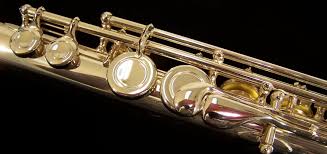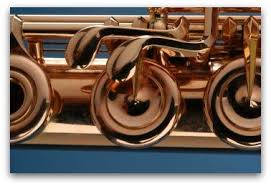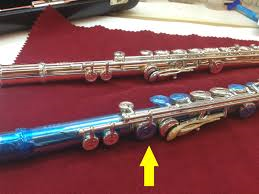Welcome to another Flute Friday.

Years ago I purchased a flute with a C# trill key and, although it seemed quite exciting at the time, I have since only used it in one or two circumstances. When the time came for one of my students to purchase an instrument with a similar feature I was a bit hesitant to recommend such a pricey add-on without doing some additional research . What are all of the functions of the C# trill key outside the obvious B-C# trills in the first and second octaves? Have I had solutions to some of my most pesky problems quite literally at the tip of my fingers all this time? There has been debate over the necessity of the key in recent forums as some performers consider the C# trill key to be indispensable while others could take it or leave it. I myself remain torn as I have appreciated the key for what it was able to accomplish in the few instances I have used it but know very well I have not explored its possibilities as much as I could. Today’s blog is devoted to this mysterious key and all of the ways the C# trill key may offer new approaches to old problems with the click of a button. Hopefully you too will find ways to incorporate these shortcuts into your own practices to improve complicated trills, tremolo patterns and other musical nuances.
What is the C# Trill Key?
The C# Trill Key is an additional key located to the left of the left hand thumb key. Connected by a long rod, this key is depressed by the first finger on the right hand using a lever placed above the standard Bb lever key. The key is rarely found on student models but has become a standard add-on to newer professional series flutes.

What does it do?
Trills
Let’s start with the most obvious trills:
- B-C# (first and second octaves): Finger B and trill the C# key. Mozart’s Concerto in D Major features these trills for example. Trills produced using the C# key are faster and better in tune.
- C-C# (first and second octaves): Finger C and trill the C# key.
..But wait….the C# trill key will also help improve the following trills which we have all encountered and have most likely all struggled to play:
- High F#-G#: Finger high F# and trill the C# key. I use the C# trill key in this instance for pieces such as the final movement of Burton’s Sonatine which features a quick, repetitive dance-like figure. Some performers consider this trill to be well worth the price of the additional key and I definitely agree. This trill has a more controlled (or centered) sound and is substantially more in tune that the standard trill fingering.
- High G-Ab: Finger high G and trill the C# key. Time to give your left hand pinky a well deserved vacation!
- High G-A: Finger high G and trill the C# trill key and D trill key in unison.This is the trill that I have used the most from the above list. The response and sound quality is greatly improved when using the C# trill key in this instance. You will notice an immediate difference particularly when playing the flute and piccolo excerpt from Tchaikovsky’s 4th Symphony, Movement III. Practice this excerpt first on the piccolo and then on the flute using the C# trill key. The ease that the key offers for one of the most difficult trills on the flute is remarkable. The only difficulty to performing this trill is that the trill key is quite close to the Bb lever key which will give you and entirely different sound if trilled by accident. Familiarize yourself with the difference in location between the Bb and C# trill levers and it will become easier to distinguish between the two with practice.
And the here is the kicker! In the past I have simply overblown a second octave Ab-Bb to achieve this trill which has often resulted in an airy, messy and out of control screaming trill (not pretty). The C# trill key is the solution to this problem and produces a quicker trill with a much sweeter sounding tone color.
- High Ab-Bb: Finger high Ab and trill the C# trill key, the D trill key and the D# trill key in unison.
Tremolos
Keep in mind that most tremolos of these types are rare however short cuts like the ones listed below will save you a lot of pain and frustration if you encounter them in your scores. Be on the lookout for these trills in pieces by Stravinsky or Varese.
- In the first octave, tremolo to C# from G, Ab, A, Bb, B or C by trilling the C# trill key.
- In the second octave, tremolo to C# from A, Bb, B or C by trilling the C# trill key.
- In the first octave, tremolo to D from G, Ab, A, Bb or B by trilling the C# trill key and the D trill key in unison.
- In the first octave, tremolo to D# from G, Ab, A, Bb or B by trilling the C# trill key and the D# trill key in unison.
Trick Fingerings
- Pianissimo high Ab: Play middle Ab with ALL the left hand keys depressed, add the C# trill and the high Ab will appear softly, and in tune. Finally the answer to our prayers! How many trick fingerings have we used to contain that terrifyingly beautiful opening high G# in Daphnis et Chloe? I can count at least 3 but none have worked quite as well as the C# trill key. I have been eliminated from auditions in the past over the color and clarity of that single note without realizing that the solution to my problems was under my fingers the whole time. There are of course countless other pieces that require the use of a soft Ab or G# but simply for the clarity, intonation and ease of tone on the Daphnis flute solo, the C# trill key is well worth the investment. This key should be required for all professional (and non-professional principal seat) orchestral players.
- Debussy C#: Use the C# trill key while fingering B natural, and you will sound a C# of a different color. This fingering produces an in tune C# (is that even possible?) with better resonance and a richer tone color. This is in part due to that fact the resistance of the note is increased with the addition of the key.This tip is magical and has changed the way I approach the opening solo in Debussy’s Afternoon of a Faun. The difficulty in this solo lays not necessarily in breath control but more so in finding variety within the tone. This is often accomplished by producing a different tone color each time the melody returns to the suspended C# which is quite difficult due to the openness of the natural C# (this note is much like the flute’s version of an open string). The C# trill key gives us more control over the suspended C# in both the first and second octaves allowing a greater spectrum of tone colors to be explored. Bonus: You will no longer need to add additional fingers on your right hand to bring down the pitch of the C#!

If you are an orchestral flute player, or would like to become one down the road, I highly recommend the C# trill key as an add-on to your instrument. If you are an amateur playing the flute for fun or a student just learning the ropes of flute playing, this key is not as necessary as, say, a D# roller, B-foot or a headjoint with a gold riser. At the end of the day the key is very useful for many of our most pesky trills and problematic notes. I plan to use the alternate fingering possibilities that the trill key offers when playing pianissimo G#/Ab on a much more frequent basis and experiment with the trills listed above that I have less experience using the C# trill key to produce. There is obviously more to this key than meets the eye and it will be interesting to see how composers utilize the key in future works. Will there be a C# Trill Key Concerto for Flute and Orchestra? Only time will tell.

Do you have a C# Trill key? How often do you use this key and in what contexts? Do you recommend this key to your students? Have you found other uses for the key than those outlined above? Please comment below.
Happy Fluting!



Leave a comment